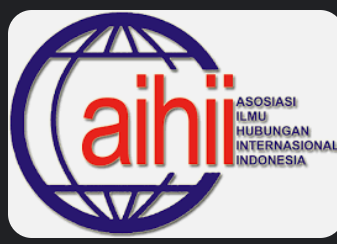Finding New Regional Mandalas: Indonesia Maritime Strategy Between India And China
DOI:
https://doi.org/10.33822/mjihi.v2i2.1321Kata Kunci:
mandala, maritime orientation, heterarchy, dissonanceAbstrak
This paper aims to analyse Indonesia’s dilemmas and prospects in engaging maritime strategic partner between China and India while pursuing its maritime reorientation. The expanding presence of China in Indian Ocean and its aggressiveness in maritime territorial dispute in East Asia has triggered India to transform Rao’s “Look East policy” to Modi’s “Act East policy”. Modi’s ambitious foreign policy increased eastward focus and his commitment in pursuing economic growth has been combined with India’s strategy in balancing against China’s Silk Road strategy. Both emerging powers, China and India, see Indonesia potential as strategic maritime partner in their strategic vision. Utilizing New Maritime Silk Road strategy or One Belt One Road (OBOR) Initiative in 2013, China engages ASEAN, including Indonesia, in infrastructure construction mega-project to enhance connectivity. While India, began in 1996 as dialogue partner in ASEAN Regional Partner (ARF), gets more involved in as ASEAN partner by joining ASEAN Defence Ministers Meeting Plus (ADMM+) in 2010 and Expanded ASEAN Maritime Forum (EAMF) in 2015. India and Indonesia have shared the common view of culture, colonial history, and political sovereignty, economic self-sufficiency, and independent foreign policy. Theyhave been also originated from the same ancient polity that habituate them to cooperate even under anarchy situation. However, this mandala-inspired cultural legacy would also drive them toward potential conflict as the two countries try to structure their spatial process centripetally using maritime strategy. In this regards, the paper will also discuss the continuity and dissonance of maritime perspective in Indonesia and India experience. Jakarta’s will to strengthen its maritime posture marks its leitmotif to play its role as center within Southeast Asia mandala will be contested by India and China strategic interests in the sea. In the cultural memory of region, exerting power on the sea and ownership of huge armada symbolically marks and legitimates a country’s supremacy within heterarchy or regional hierarchy that tends to be equal. Using both contemporary and classical literature, this research intends to reveal how the contending emerging powers seek to aspire regional leadership using maritime tradition. While embarking from leadership-generational change and historical experience, this paper will shed the light why maritime strategy acts as guiding principles for national security in the global geopolitical shift and regional geo-strategy.
Referensi
Agistia, I. G. Bagus Dharma, and Perwita, AA. Banyu. (2015). “Jokowi’s Maritime Axis: Change and Conituity in Indonesia’s Role in Indo-Pacific”. Journal of ASEAN Studies. Vol. 3, No. 1
Ali, Fachry. (1986). Refleksi Paham “Kekuasaan Jawa” dalam Indonesia Modern. Jakarta: Gramedia.
Amitav, Acharya and Buzan, Barry. 2010. Non-Western International Relations Theory: Perspectives on and beyond Asia. Routledge: Abingdon
Antara News Online. 2014. “Di EAS Jokowi Beberkan Lima Pilar Poros Maritim Dunia”. Antara News. Available online https://www.antaranews.com/berita/464097/di-eas-jokowi-beberkan-lima-pilar-poros-maritim-dunia> Accessed 19 April 2018.
Chong, Alan. (2010). “Southeast Asia: Theory between Tradition and Modernization”, in Amitav, Acharya and Buzan, Barry. 2010. Non-Western International Relations Theory: Perspectives on and beyond Asia. Routledge: Abingdon
Dellios, Rosita. (2003). “Mandala: From Sacred Origin to Sovereign Affair in Traditional Southeas Asia”. CEWCES Research Paper. Paper 8. Queensland: Bond University
Dellios, Rosita,.(2003b). “China dan India: New Mandalas of Power in 21st Century Geopolitics”. Humanities and Social Science Papers. Paper 103. Queensland: Bond University
Geertz, Clifford. (1980). Negara: The Theater State in Nineteenth Century Bali. Princeton: Princeton University Press
Gindarsah, Iis and Priamarizki, Adhia. (2015). “Indonesia’s Maritime Doctrine and
Security Concerns”. RSIS Policy Report. Singapore: RSIS
Goh, Evelyn. (2008). “Great Powers and Hierarchical Order in Southeast Asia: Analyzing Regional Security Strategies”. International Security 32 No.3, Winter.
Jacques, Martin. (2011). When China Rules the World: Kebangkitan Dunia Timur dan Akhir Dunia Barat. Jakarta: Penerbit Buku Kompas
Lieberman, Victor. (2003). Strange Parallel: Southeast Asia in Global Context, c 800-1830, Vol. 1 Integration and Mainland. Cambridge: Cambridge Universoty Press
Manggala, Pandu Utama. (2013). “The Mandala Culture of Anarchy: The Pre-Colonial Souteast Asian International Society”. Journal of Asian Studies No. 1/Vol.1. Jakarta: Bina Nusantara University and Indonesian Association of IR
Rajendram, Danielle. 2014. India’s New Asia-Pacific Strategy: Modi Acts East. Sydney: Lowy Institute for International Policy
Roger, James, and Simon, Luis. 2014. “Think Again: European Geostrategy”. Ideas on Europe. Available online https://web.archive.org/web/20100424042233/http://europeangeostrategy.ideasoneurope.eu/2010/03/14/think-again-european-geostrategy/ Accessed 18 April 2018
Shambaugh, David, and Yahuda, Michael (eds.). (2011). International Relations of Asia. Plymouth: Rowman and Littlefield
Susanto, Joko. (2015). “Evolusi Strategi Maritim Indonesia” dalam Susilo, Ignatius Basis. Kemaritiman Indonesia: Problem Dasar Kemaritiman Indonesia. Surabaya: CSGS Universitas Airlangga
Tambiah, Stanley Jevaraja. (2013). “The Galactic Polity in Southeast Asia”, HAU Journal of Ethnographic Theory 3 (3): 503-534. Chicago: University of Chicago Press
The State Council, The People‟s Republic of China, (2017), Full Text of the Vision for
Maritime Cooperation under The Belt and Road Initiative, Tersedia online dari:
<http://english.gov.cn/archive/publications/2017/06/20/content_281475691873460.htm>, diakses pada 20 April 2018





